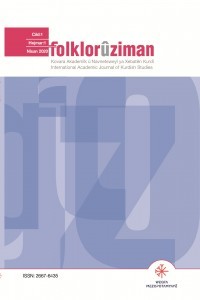The Customs and Traditions Clustered Around Birth From The Rites Of Transition: The Example Of The Sewreg Region
The Customs and Traditions Clustered Around Birth From The Rites Of Transition: The Example Of The Sewreg Region
There are crucial and critical moments in each human being. Everybody in a community experiences these experiences once in their lifetime. These periods are referred to in the literature of folklore as the transition periods as these periods bring about some changes both in human life and in the social system. It can be said that the times of birth, marriage and death are critical times for any society. Around these critical times many customs and traditions gather to reflect the colors and shapes of the people in the background of each tradition and custom. The aim of this study is to show these customs and traditions that gather around the birth rites and show the characteristics of the Kurdish people, especially the Kurds of Sêwreg. This work has been done on the birth rites of the Sêwreg region. In this study we wanted to collect the customs and traditions that gather around the rites of passage, to pass them on to the new generations and to show the special culture of Sêwreg in the region. To this end, we conducted fieldwork in the Sêwreg region and, in particular, provided an overview of these customs and traditions through monitoring and interviews. According to the information obtained, the customs and traditions that gather around the rites of passage of birth were classified and evaluated according to their subjects. As a result of this study it was found that the roles and functions of birth rites are effective both on the individual and on society.
___
- Çelik, Ö.(2008). Ataerkil Sistem Bağlamında Toplumsal Cinsiyet ve Cinsiyet Rollerinin Benimsenmesi, Teza Lisansa Bilind Ya Çapnebûyî, Ankara: Gazi Üniversitesi, Sosyal Bilimler Enstitüsü.
- Emiroğlu, K. û Aydın, S.(2003). Antropoloji Sözlüğü, Ankara: Bilim ve Sanat Yayınları.
- Farqînî, Z.(2010). Ferhenga Kurdî-Tirkî, Çapa Sêyem, Stenbol: Weşanên Enstîtuya Kurdî ya Stenbolê.
- Honko, L.(2015). Ritüellerin Oluşum Süreci(Wer. Ruhi Ersoy), M. Ö. Oğuz, S. Gürçayır Teke û S. Akkaya(Ed.). Di nav Halk Biliminde Kurumlar ve Yaklaşımlar 3 de, r. 199-212, Ankara: Geleneksel Yayınları.
- Kahraman, K.(2010). Ritüellerin Toplumsal Etkileri, S. Seydi û H. Çapraz(Ed.). Di nav SDÜ Fen Edebiyat Fakültesi Sosyal Bilimler Dergisi de, hejmar 21, r. 227-236, Isparta: Süleyman Demirel Üniversitesi Fen Edebiyat Fakültesi.
- Örnek, Sedat V.(1977). Türk Halk Bilimi, Ankara: İş Bankası Kültür Yayınları.
- Suvari, Çakır C. û Kanca E.(2011). Ezidi Bayramı ‘Çarşema Sor’ un Toplumsal Geçiş Ritüeli Olarak Analizi, Sempozyum Bildirileri Uluslararası Midyat Sempozyumu, Midyat: r.675-684.
- Lîsteya Jêderkên Devkî JD-1: Nuriye Candan, 61 Salî, Nexwende, Kebaniya Malê, Navenda Sêwregê.
- JD-2: Lütfiye Özlahlan, 78 Salî, Nexwende, Kebaniya Malê, Navenda Sêwregê.
- JD-3: Cemile Karalük, 53 Salî, Nexwende, Kebaniya Malê, Navenda Sêwregê.
- JD-4: Gafure Devebakan, 77 Salî, Nexwende, Cotkarî, Gundê Daraxunê.
- JD-5: Fatime Çalışkan, 86 Salî, Nexwende, Kebaniya Malê, Gundê Sawicaxê.
- JD-6: Fatime Künç, 58 Salî, Mezûna Dibistana Seretaayî, Kebaniya Malê, Navenda Sêwregê.
- JD-7: Zeynep Güzeler, 75 Salî, Nexwende, Kebaniya Malê, Gundê Qurdekê.
- JD-8: Saadet Hamkan, 70 salî, Nexwende, Kebaniya Malê, Navenda Sêwregê.
- JD-9: Emîne Kayçi, 93 Salî, Nexwende, Pîrik, Gundê Kerteşê.
- ISSN: 2667-6435
- Başlangıç: 2020
- Yayıncı: Mezopotamya Eğitim Bilim Sanat Sağlık Ve Kültür Vakfı İktisadi İşletmesi
